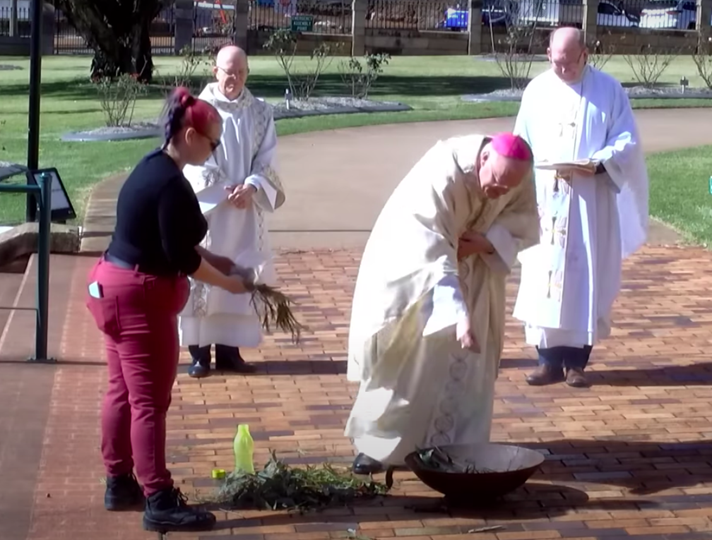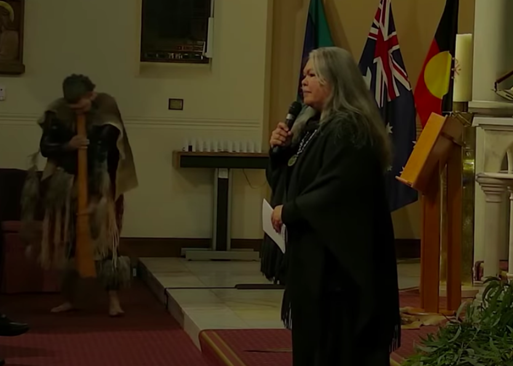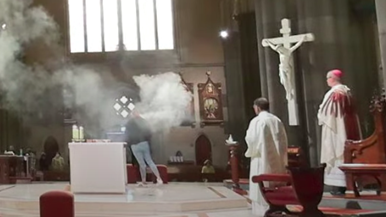The Pillar article looked at the recent installation of Bishop Ken Howell at his new diocese of Toowoomba, in Queensland, Australia. The installation Mass was preceded by an Aboriginal smoking ceremony; these have unfortunately become commonplace at both Catholic and secular events.

According to the article, the smoking ceremony was part of a ‘Welcome to Country’ ceremony, although these are in fact two distinct rituals. A ‘Welcome’ involves acknowledging the traditional custodians of the land on which an event takes place, and does not always include a smoking ritual. A smoking ceremony is a separate ritual which, according to Aboriginal Australians, is meant to ward off bad spirits.
At Bishop Howell’s installation, both the Welcome and the smoking ceremony were presided over by a young, jeans-clad indigenous woman. Her casual attire and indecorous attempts to keep the small fire smoking stood in marked contrast to the liturgical solemnity. After first paying her respects to her elders and to those of the congregation and priests who were watching on screens from within the Cathedral, the young woman invited Bishop Howell to breathe in the smoke she had created from burning native plants. She then invited him to offer a pinch of sandalwood and ‘make a wish’.
For serious Catholics, this gesture brings to mind the choice given to the early Christians during the time of Roman persecutions. In order to escape death, they had merely to offer a pinch of incense to Caesar, the Roman king who was revered as a god.
For serious Catholics, this gesture brings to mind the choice given to the early Christians during the time of Roman persecutions. In order to escape death, they had merely to offer a pinch of incense to Caesar, the Roman king who was revered as a god. Those who refused often faced a series of gruesome tortures before eventually receiving a martyr’s crown. Those who accepted saved their lives at least temporarily, but at the very high cost of violating the first commandment and betraying their God.
At Bishop Howell’s installation, the young woman explained that the smoking ceremony would “bring in healing and positive vibes” and “cleanse and remove past negative energies.” She expressed the hope that it would bring “peace and good energies, success and confidence”. Hold onto that thought while we look at comments made by Archbishop Chaput, OFM Cap after he was contacted by The Pillar for his input.
The Archbishop first stated that for incensations, Catholics may use any kind of receptacle and any kind of incense. He also said that the laity can legitimately use incense outside of the liturgy “as long as the prayers and intentions are correct.”
Archbishop Chaput stated:
“The real issues are the prayers used and the intention behind the act which specify its meaning. Unfortunately many people use prayers that do not fit within Catholic theology and that is always a problem … if they are Christian prayers and the intention is the same as the Church’s use of incense implies, then I do not see a problem.”
So, did the woman’s intention match the intention Catholics are meant to have when using incense? A little history lesson is in order.
Since ancient times, incense has been used by pagans to drive away demons. The Jews, however, in obedience to God, used incense with their thanksgiving offerings, and it was kept burning near the Ark of the Covenant in Mosaic times. During the Catholic liturgies, incense is associated with purification and sanctification, and also represents our prayers rising to God in heaven. So clearly, the meaning of incensation varies according to different religions.
That priest and two other exorcists contacted by this author said that they had grave reservations about anyone attending smoking ceremonies.
As Monsignor Romano Guardini wrote, for Catholics, the use of incense is an extravagant offering from the created to the Creator; “ …the offering of incense is like Mary’s anointing (of Jesus) at Bethany. It is as free and objectless as beauty. It burns and is consumed like love that lasts through death.”
That awe-inspiring thought is a far cry from an indigenous smoking ceremony which purports to replace “negative vibes” with some “positive energy.” The intentions of the smoking practitioner sound a lot more like a pagan attempt to drive out demons than about thanking and honoring God. In fact, the young woman made no mention of God. In the opinion of other Australian smoking ceremony practitioners, the ritual is most definitely about trying to drive away bad spirits. This is hardly consistent with Catholic theology which states that the smoke is merely symbolic, that it represents thanksgiving and that only priests, in union with Christ, possess the authority to drive away demons.
Thus it appears that by Archbishop Chaput’s definition, the prayers said outside the Toowoomba Cathedral did not match the criteria he set down as necessary when a layperson conducts an incensation. In fact, the prayers and intentions of the indigenous practitioner actually conflict with Catholic doctrine.
The article also contained an error which is less serious but which is instructive: Archbishop Chaput is quoted as referring to the form of incensation used at Bishop Howell’s installation as “smudging”. According to a witchcraft website visited by this author, that term is usually reserved to indigenous American rituals. As the article states, Archbishop Chaput is himself a member of Prairie Band Potawatomi Nation, and as such is not familiar with indigenous Australian smoking ceremonies. The latter are said to be similar to the rituals practiced more broadly throughout the world, as distinct from native American ceremonies. This may seem like a small mistake, but it points to the article being a very superficial survey of a topic which urgently needs to be addressed by the Church in a very thorough manner, as souls are at risk.
By far the most pressing issue is the spiritual dangers inherent in any form of pagan smoking ceremony. Last year, this author spoke with the mother of a child who had seen a demonic entity in his bedroom after being made to participate in a smoking ceremony at school. The young child was unable to sleep, for fear of seeing the demon again. This meant that the whole household was unable to get a good night’s rest. The mother told me that she had eventually taken her child to see a priest, a former exorcist, who had prayed deliverance prayers over him. That priest and two other exorcists contacted by this author said that they had grave reservations about anyone attending smoking ceremonies. One priest, a member of the US-based Dolorans Fathers, wrote that his order of exorcists had seen people requiring deliverance after attending indigenous smoking rituals from cultures other than that of Australian Aborigines.
The use of pagan rituals alongside Catholic liturgies paints a disconcerting picture of a post-conciliar Church confused by a misplaced sense of tolerance and obedience.
It seems quite irresponsible for an influential publication like Pillar Catholic to present indigenous rituals as being harmless and appropriate for use in a liturgical context. At the very least, such rituals cause confusion to the faithful. By performing a smoking ceremony in close proximity to a Catholic liturgy, in which incensation is often an integral part, the faithful are led to believe that the two are interchangeable. If it was the intention of The Pillar to suggest that such ceremonies are not appropriate, then that should have been spelled out very clearly.
For it is not only the laity who are being confused by pagan rituals masquerading as inculturation. At the opening Mass of last year’s Plenary Council, an indigenous woman addressed the congregation prior to Mass, “asking permission” of her ancestors before the Mass took place. The women had processed into the church with a man wearing animal skins who was playing a didgeridoo, and with another man who was spreading the smoke from burning leaves throughout the church.
 Screengrab from the Plenary Council Youtube account
Screengrab from the Plenary Council Youtube account
Even worse, the Archbishop of Melbourne, Peter Comensoli, two years ago presided over a Mass for Aboriginal and Torres Strait Islander Sunday at which incensation took place on the sanctuary itself and within the Mass. The Archbishop, wearing indigenous-patterned vestments, looked on as the altar was incensed by an indigenous woman after he had made the Sign of the Cross and welcomed the congregation.
 Screengrab from Archdiocese of Melbourne Youtube account
Screengrab from Archdiocese of Melbourne Youtube account
The use of pagan rituals alongside Catholic liturgies paints a disconcerting picture of a post-conciliar Church confused by a misplaced sense of tolerance and obedience. What for The Pillar should have been a valuable teachable moment instead devolved into yet another apologia for syncretism.
Latest from RTV — THE FBI’s OBSESSION: Latin Mass Catholics & the Conspiracy that Canceled Benedict





